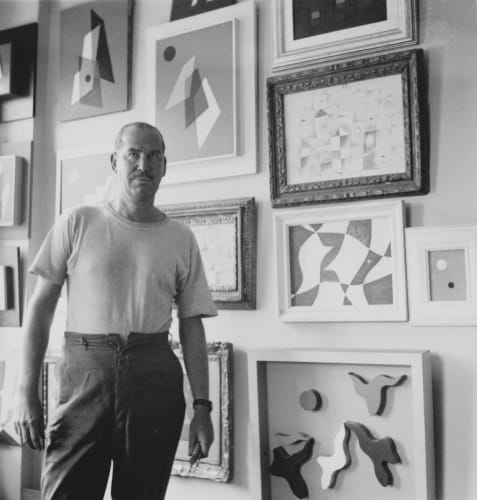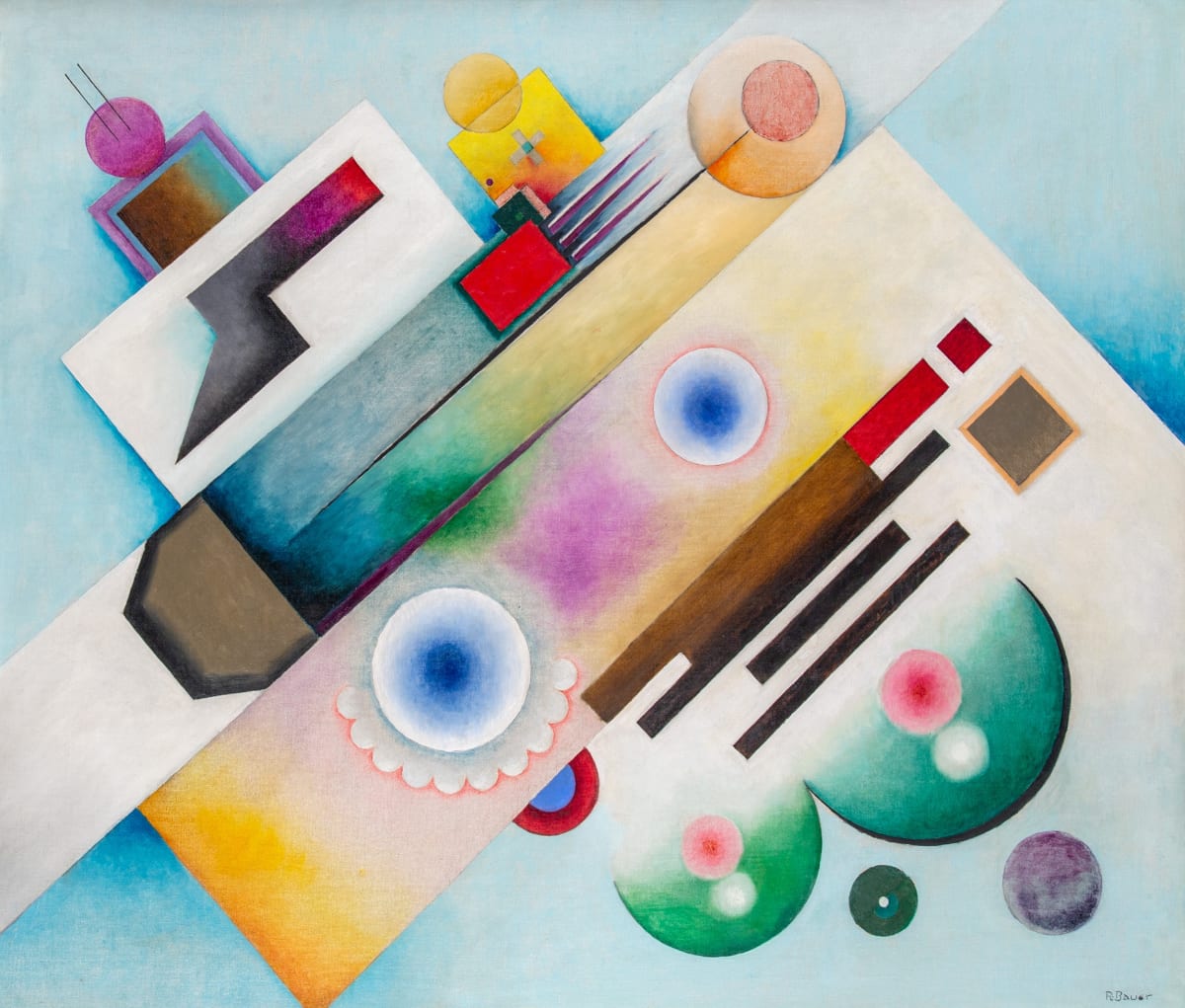As a key figure in early American abstraction, Charles Green Shaw was a unique amalgamation of a multifaceted life, education and career that resulted in a significant and beautiful body of art. Shaw holds the special recognition of being the only American born artist to be awarded two solo exhibitions during his lifetime at Solomon Guggenheim's Museum of Non-Objective Painting (MNOP).
He also was a founding member of the American Abstract Artists group (AAA), established in 1936 in New York City to champion the understanding of abstract art. Henry Adams, Professor of Art History, Case Western Reserve University, described Shaw as such:
Indeed, few American painters of the 1930s and 1940s left an oeuvre which is so varied and consistently original. The distinction that should be made … is that Shaw was not a framer of epics but a lyric poet. His paintings have something of the quality of Japanese haiku, by a poet such as Basho, which capture the metaphysical thrill of an ecstatic moment, with a clarity, a brevity, that is breathtaking. In this particular mode, Charles Green Shaw has no serious rival.1
Shaw took a circuitous journey to life as an artist. From a wealthy New York family, he graduated from Yale in 1914 and completed a year of architectural studies at Columbia. In the 1920s he pursued journalism, writing articles on the city nightlife for The New Yorker, Vanity Fair and The Smart Set. Then in 1927, he began drawing, taking class at the Art Students League with Thomas Hart Benton and Georges Luks of the Ash Can School, delving into the tradition of portraiture, still life and landscapes.
Whether it was writing, traveling, or creating artwork, Shaw was a combination of intense observation, research, and education, followed by fearless and independent experimentation and pursuit. In the late 1920s and early 1930s, he took a long trip to Europe, living in Paris and London, traveling to Berlin, Vienna, Budapest, Florence, Rome, visiting museums, spending time with artists, reading about various genres of art, taking drawing classes, all while staying abreast of American trends. He met with fellow abstractionists Jean Hélion, Joan Miró and Le Corbusier in Paris, and with the artists Georges Braque, Constantin Brancusi, Wolfgang Paalen, Man Ray, Ben Nicholson, Barbara Hepworth and John Ferren. This continuous and diverse exposure enriched Shaw's development as an artist and allowed him to become a special and original combination of American and European aesthetics.
Upon his return to the U.S. in 1933, Shaw began to depict abstracted versions of cityscapes, with the distinctly American imagery of the Manhattan skyscrapers appearing in his compositions in various degrees of abstraction. His immersion into the city and its resulting influence on his art was likely furthered as he undertook photography of New York and Brooklyn, used alongside his 1936 article on historical sites and becoming the book New York-Oddly Enough in 1938. Sharing similar artistic pursuits and ideals in American abstraction as well as friendship, Shaw, along with the artists George L. K. Morris, Suzy Frelinghuysen, and Albert Eugene Gallatin, became known as the "Park Avenue Cubists," a sophisticated group who pursued their own art and promoted the art of others.
Galleries and institutions with varying artistic focuses exhibited the work of Charles Green Shaw. Julien Levy, whose gallery was a prime venue for Surrealism and the avant-gardes, showed his paintings in 1934, as did Valentine Dudensing, a major figure in modern art in New York. At the Gallery of Living Art-the first public collection of modern art in the U.S. (renamed the Museum of Living Art in 1936)-the director A. E. Gallatin allowed for the institution's first one-man exhibition by showing the art of Shaw, and additionally he acquired a piece for the collection. In the early 1940s, Katherine Dreier, founder of the Société Anonyme with Marcel Duchamp, encouraged Karl Nierendorf to exhibit Shaw's work. He showed with the MNOP's anniversary exhibition, and in the annual exhibitions at the Art Institute of Chicago, Carnegie Institute and Whitney Museum of American Art.
In 1940 Shaw exhibited extensively, with AAA, the Arts Club of Chicago, the San Francisco Museum of Modern Art, Seattle Art Museum, and Museum of Non-Objective Painting in New York becoming closer with Hilla Rebay, Rudolf Bauer and Rolph Scarlett. His paintings and reliefs were included in the New York World's Fair exhibition, one of which Rebay acquired for the MNOP. Since the museum's founding in 1939, Shaw was the only artist to be given a solo show until a 1941 exhibition of Lászó Moholy-Nagy and its memorial exhibition for Vasily Kandinsky in 1945.
It is understandable that divergent locations would exhibit Shaw's work, as his own personal artistic vocabulary contained diversified elements of modernism, including hints of Cubism, Surrealism, and Non-Objectivity. He took these influences and forged a personalized path with the use of subtle textural variations, experiments in shapes, fine elegant lines of delicate precision, and defined colors gently overlapping or hovering in space. He could express whimsy and lyricism with the shapes in his canvases, utilizing different composites and textures, leading to biomorphic wood reliefs with birdlike forms in flight. Forms alternate from the nearly recognizable to abstracted essence. In a 1938 AAA show he also contributed an essay, "A Word to the Objector," to the accompanying book, writing:
For honest painting, regardless of its representational or non-representational merits, embraces certain patent fundamentals. One seeks, for example, rhythm, composition, spatial organization, design, progression of color, and many, many other qualities in any aesthetic work.
Charles Green Shaw's works can be found in the collections of the Metropolitan Museum of Art, New York; Museum of Modern Art, New York; Guggenheim Museum, New York; Brooklyn Museum; Art Institute of Chicago; San Francisco Museum of Modern Art; Philadelphia Museum of Art; Whitney Museum of American Art, New York; Smithsonian American Art Museum, Washington, D.C.; Yale University Art Gallery, CT; Dallas Museum of Art, TX.
Notes
-
Henry Adams, "Charles Green Shaw (1892–1974): A Portrait in Words." Charles Green Shaw (1892– 1974): The 1930s & 1940s (New York: D. Wigmore Fine Art, Inc., 2007), 11.
Select Public Collections
- Addison Gallery of American Art, Phillips Academy, Andover, MA
- Ackland Art Museum, University of North Carolina, Chapel Hill, NC
- Akron Museum of Art, Akron, OH
- Alan R. Hite Art Institute, University of Louisville, Louisville, KY
- Art Institute of Chicago, Chicago, IL
- Atlanta University, Atlanta, GA
- Baltimore Museum of Art, Baltimore, MD
- Berkshire Museum, Pittsfield, MA
- Brooklyn Museum of Art, Brooklyn, NY
- Carnegie Museum of Art, Pittsburgh, PA
- Cantor Art Center, Stanford University, Palo Alto, CA
- Cincinnati Art Museum, Cincinnati, OH
- The Cleveland Museum of Art, Cleveland, OH
- Corcoran Gallery of Art, Washington, D.C.
- de Young Museum, Fine Arts Museums of San Francisco, San Francisco, CA
- The Dayton Art Institute, Dayton, OH
- Denver Art Museum, Denver, CO
- Fort Worth Community Arts Center, Fort Worth, TX
- Georgia Museum of Art, Athens, GA
- Grey Art Gallery, New York University, New York, NY
- Solomon R. Guggenheim Museum of Art, New York, NY
- High Museum of Art, Atlanta, GA
- McNay Art Museum, San Antonio, TX
- Memorial Art Gallery, University of Rochester, Rochester, NY
- Metropolitan Museum of Art, New York, NY
- Le Musée de l’Art Moderne, Paris, France
- Museum of Fine Arts, Boston, MA
- Museum of Modern Art, New York, NY
- Newark Museum, Newark, NJ
- National Gallery of the Arts, Washington, D.C.
- North Carolina Museum of Art, Raleigh, NC
- Pennsylvania Academy of the Fine Arts, Philadelphia, PA
- Philadelphia Museum of Art, Philadelphia, PA
- The Phillips Collection, Washington, D.C.
- Phoenix Art Museum, Phoenix, AZ
- Rhode Island School of Design Museum, Providence, RI
- Rockefeller University, New York, NY
- Saint Louis Art Museum, St. Louis, MO
- San Francisco Museum of Modern Art, San Francisco, CA
- Sheldon Memorial Art Gallery, Lincoln, NE
- Smithsonian American Art Museum, Washington, D.C.
- Wadsworth Atheneum Museum of Art, Hartford, CT
- Weatherspoon Art Museum, University of North Carolina, Greensboro, NC
- Whitney Museum of American Art, New York, NY
- Wichita Art Museum, Wichita, KS
- Yale University Art Gallery, New Haven, CT








